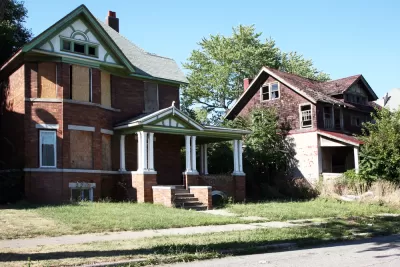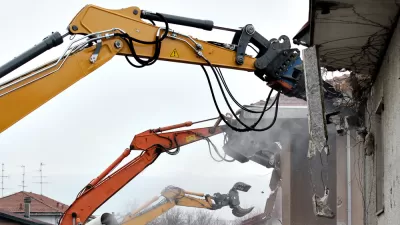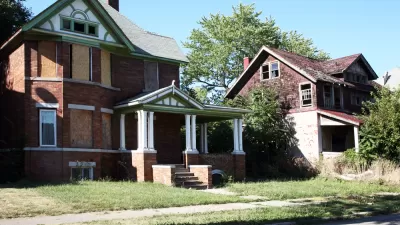The city of Detroit said it would halt a demolition program after a report revealed the amount of lead released by demolitions into the environment, risking the health of children and other local residents.

Kat Stafford and Kristi Tanner provide a bombshell investigative report into the public health outcomes of demolitions in the city of Detroit, finding a trail of broken promises and children at risk from high levels of lead.
Here, Stafford and Tanner summarize the crux of the story:
A 2017 Detroit Health Department task force report concluded there was a potential link between the high number of demolitions occurring in the city during the summer months and elevated blood lead levels of children who live near the demolition sites. The city announced in early 2018 that it would halt nonemergency demolitions in five of the most at-risk ZIP codes — 48202, 48204, 48206, 48213 and 48214 — from May through September.
Except it didn't.
Stafford and Tanner, at the Detroit Free Press, worked with Type Investigations to analyze the nonemergency demolitions approved by the city in the wake of the Detroit Health Department report, finding a large number of approvals. "Work crews in those same neighborhoods continued to raze a total of 219 homes during mid-2018 and in mid-2019. Almost half of them were nonemergency demolitions," according to Stafford and Tanner.
Moreover, the city is "now asking voters to approve a quarter-billion-dollar bond referendum to do even more demolitions." Proposal N for Neighborhoods, also documented in an article by Violet Ikonomova, is on the citywide ballot on November 3.
The article includes a soundbite from U.S. Rep. Rashida Tlaib, D-Detroit, who responds to the data reported in the article by calling the demolitions a "grave injustice" for the communities impacted by the environmental risks of demolitions.
FULL STORY: Children were at risk so Detroit promised to halt demolitions. But that didn't happen.

Alabama: Trump Terminates Settlements for Black Communities Harmed By Raw Sewage
Trump deemed the landmark civil rights agreement “illegal DEI and environmental justice policy.”

Study: Maui’s Plan to Convert Vacation Rentals to Long-Term Housing Could Cause Nearly $1 Billion Economic Loss
The plan would reduce visitor accommodation by 25% resulting in 1,900 jobs lost.

Why Should We Subsidize Public Transportation?
Many public transit agencies face financial stress due to rising costs, declining fare revenue, and declining subsidies. Transit advocates must provide a strong business case for increasing public transit funding.

Paris Bike Boom Leads to Steep Drop in Air Pollution
The French city’s air quality has improved dramatically in the past 20 years, coinciding with a growth in cycling.

Why Housing Costs More to Build in California Than in Texas
Hard costs like labor and materials combined with ‘soft’ costs such as permitting make building in the San Francisco Bay Area almost three times as costly as in Texas cities.

San Diego County Sees a Rise in Urban Coyotes
San Diego County experiences a rise in urban coyotes, as sightings become prevalent throughout its urban neighbourhoods and surrounding areas.
Urban Design for Planners 1: Software Tools
This six-course series explores essential urban design concepts using open source software and equips planners with the tools they need to participate fully in the urban design process.
Planning for Universal Design
Learn the tools for implementing Universal Design in planning regulations.
Smith Gee Studio
Alamo Area Metropolitan Planning Organization
City of Santa Clarita
Institute for Housing and Urban Development Studies (IHS)
City of Grandview
Harvard GSD Executive Education
Toledo-Lucas County Plan Commissions
Salt Lake City
NYU Wagner Graduate School of Public Service





























